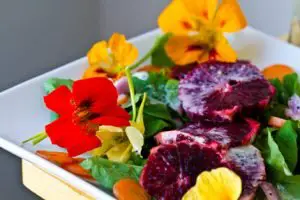There is nothing more pleasurable or more “gourmet” than adding edible flower petals in a salad, as lovely receptacles on a savory mousse, garnish on ice cream, a bouquet of wild pansies as a chocolate cake decoration, or a stir-fried daylily bud in a stir-fry. The sweet petals can be sauteed in butter for a flavorful, early-summer side dish, or processed in the food processor with a touch of goat cheese or cream cheese, olive oil, and pine nuts for a delicious pesto for your taste buds.
Picking edible flowers right from your garden is a fun and easy way to add a wide range of colors and flavors to a variety of dishes. You can use herb flowers for garnish on plates or décor, but avoid using non-edible and roadside flowers this way.
 You can eat most edible flowers raw — just pick and rinse with water. The best time to enjoy the delicate flavour and appearance of fresh flowers is right after they have been opened, not a few days later.
You can eat most edible flowers raw — just pick and rinse with water. The best time to enjoy the delicate flavour and appearance of fresh flowers is right after they have been opened, not a few days later.
It is important to remember two things about edible flowers: First, not every flower is edible. You should be careful because there are some toxic flowers. So stick with the plant flowers on this list, or do adequate research to make sure you’re safe. Introduce beautiful flowers slowly so that allergic reactions or stomach upset can be identified.
Second, avoid flowers that have been sprayed with insecticides, fungicides, or herbicides which are usually flowers from florists. Most edible flowers, except for roses, are easy to grow, so it shouldn’t be a problem. Keep dandelions off the list unless you have organic flower beds. If you want flowers that look good as well as taste good, consider the following:
Alliums. Leeks, chive blossoms (Allium schoenoprasum), and garlic taste great in green salads, potato salads, and pasta salads. You can loosen the blossom by cutting the central stem to release individual florets.
Nasturtiums. Nasturtium blossoms have a peppery flavor that tastes like watercress. All of the entire flowers and leaves can be eaten as salads or garnishes, too.
Begonias. The bright citrus taste and slight sour undertones make the begonia flower a flavorful, versatile edible flower. The flowers have oxalic acid which can be bad for people with rheumatism and kidney stones.
Marigold. The blossoms of African marigolds and signet marigolds, such as Lemon Gem and Tangerine Gem, have a lemony taste.
Borage. Borage flowers are often used in drinks and smoothies to cool down in summer. While the flowers are considered edible, the leaves have a pleasant taste and can be used as a salad green.
You can take your drinks to the next level. Put edible Johnny jump-up flowers in an ice cube tray and add to your favorite beverage.
Pansies and Johnny Jump-ups. Cakes and other desserts are embellished with these flowers’ wintergreen, grassy flavor and glazed with warmed jelly to give the appearance of jewels.
Hibiscus. Made popular in hibiscus tea, the acidic petals have a cranberry-like flavor, hibiscus petals both have a tart and sweet taste, making them perfect for tea and cocktails.
Calendula or Pot Marigolds. A prolific and easy-to-grow edible flower that can be planted right in your yard. Petals from the gorgeous flowers are prepared by separating the petals from the center and adding them as a salad garnish. Colors range from pure yellow flowers to orange and red. The plants will bloom continuously from early summer into late fall by removing spent flowers.
English Daisy. The low-growing flower is edible and has a bitter flavour. Before consuming, the white portion of the petals must be removed.
Anise hyssop. If you love anise, this is the edible flower for you. Separate the colored flowers and add them to savory dishes or sweet dishes. You can also garnish a cheese plate with the full flowers.
Scarlet runner beans. Combine bright-red flowers with salads or steamed vegetables.
Daylily. The buds and flowers of the daylily have a mild vegetable flavor. You can use them as garnishes, or stuff them, or make them into fritters. Excellent to be used in stir-fries, too.
Honeysuckle. Fruit salads with the honeysuckle species blossoms look lovely. Honeysuckle berries are poisonous, so do not use them.
Bee balm. The bee balm blossoms of the mint family have a minty flavor. Colors range from bright red to purple and pink.
Mint. Like bee balm, all flowers belonging to the mint family have a pleasing floral flavor and can be used in iced tea in addition to lemon balm.
Chamomile. You might want to avoid English chamomile if you’re allergic to ragweed, which has daisy-like flowers with a sweet flavor.
Gladiolus. Sweet spreads and savory spreads work beautifully with flowers, but they have a nondescript flavor.
Roses. Rose petals contain flavor reminiscent of strawberries and green apples. Their floral taste with subtle undertones is more noticeable in darker varieties. You need to remove the white base or the bitter base and the perfumed flavor of the individual petals especially of the miniature varieties is perfect on drinks.
Rosemary. It’s nicely added to dishes as a garnish; flowers taste muted, like a milder version of the herb.
Squash blossoms. Just as you would with daylilies (see above).

